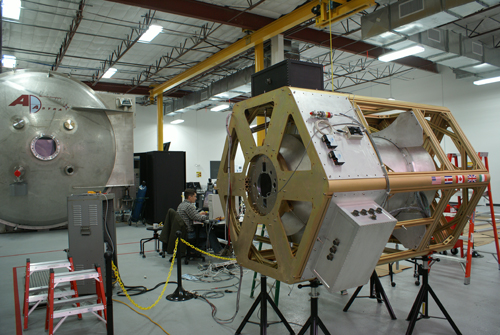D
docm
Guest

Press release (PDF).....
PRESS RELEASE 020709, July 2, 2009
VX-200 demonstrates superconducting first
stage at full power.
[Houston, TX. For immediate release] – Ad Astra
Rocket Company has successfully demonstrated
operation of its VX-200 plasma engine first stage at full
power and under superconducting conditions in tests
conducted today at the company’s Houston laboratory.
This achievement is a key milestone in the engine’s
development and the first time a superconducting plasma
rocket has been operated at that power level.
Today’s tests build on the achievements of the VX-200i,
the engine’s non-superconducting predecessor, which
last fall underwent similar tests but under a greatly
reduced set of requirements. A major difference between
the two is the superconducting magnet, featured in the
present system, which provides a ten-fold increase in the
magnetic field and enables operation of the engine under
conditions consistent with actual space flight.
The VX-200 superconducting magnet, the first of its
kind, was delivered to Ad Astra’s Houston facility on
February 10, 2009 by its manufacturer, Scientific
Magnetics of Oxford, U.K. After successful acceptance
tests, the superconductor was installed in the engine
module, replacing the conventional magnet that had been
used in the interim. This interim magnet, although
incapable of reaching the strong magnetic fields required
for full rocket performance, enabled the integrated
testing of the remaining engine sub-systems while the
company awaited delivery of the superconductor. First
plasma in full superconducting mode was achieved on
June 24, 2009.
The successful first stage tests conducted today are
critically important and are prerequisites to operational
testing of the second stage of the engine. This activity is
expected to commence on July 14, 2009, after the team
completes a full analysis of the new data. The second
stage is designed to inject up to 170 kW of additional
power into the plasma for a total of 200 kW, the engine’s
total rated power.
The present configuration achieves drastic increases in
key rocket performance parameters over previous VX-
200i results, including a 5-fold increase in propellant
flow rate and an equivalent increase in the rate of plasma
production with a ten-fold increase in the magnetic field,
all consistent with the conditions required for space
flight.
The VX-200 engine is the first flight-like prototype of
the VASIMR® propulsion system, a new high-power
plasma-based rocket, initially studied by NASA and now
being developed privately by Ad Astra. VASIMR®
engines could enable space operations far more
efficiently than today’s chemical rockets and ultimately
they could also greatly speed up robotic and human
transit times for missions to Mars and beyond
>
>



